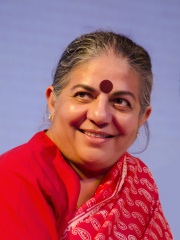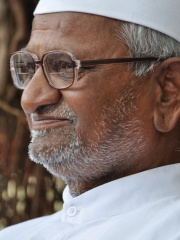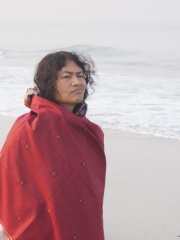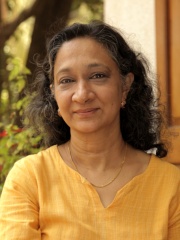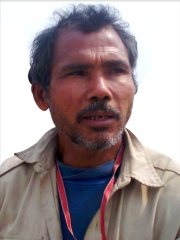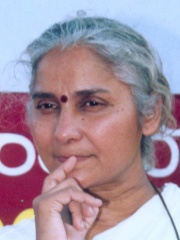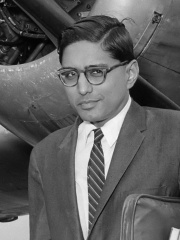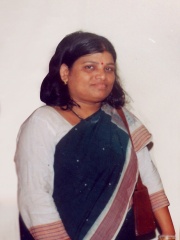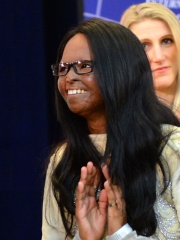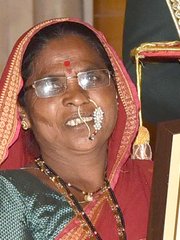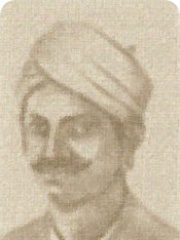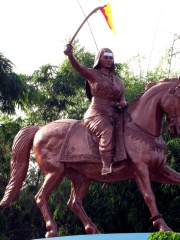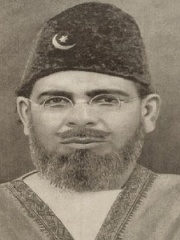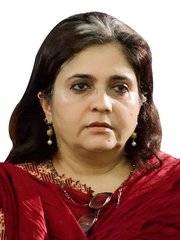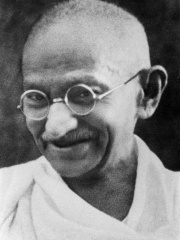

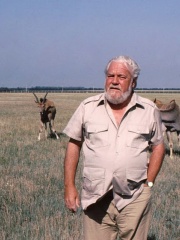
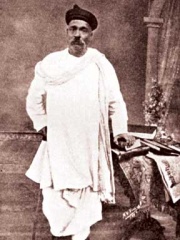
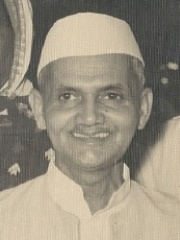
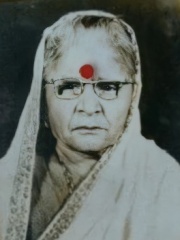
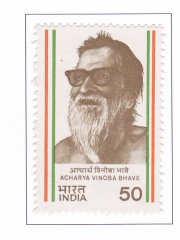
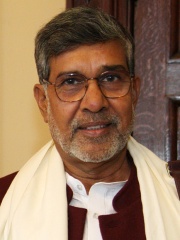
The Most Famous
SOCIAL ACTIVISTS from India
This page contains a list of the greatest Indian Social Activists. The pantheon dataset contains 840 Social Activists, 62 of which were born in India. This makes India the birth place of the 2nd most number of Social Activists.
Top 10
The following people are considered by Pantheon to be the top 10 most legendary Indian Social Activists of all time. This list of famous Indian Social Activists is sorted by HPI (Historical Popularity Index), a metric that aggregates information on a biography's online popularity. Visit the rankings page to view the entire list of Indian Social Activists.

1. Mahatma Gandhi (1869 - 1948)
With an HPI of 97.71, Mahatma Gandhi is the most famous Indian Social Activist. His biography has been translated into 203 different languages on wikipedia.
Mohandas Karamchand Gandhi (2 October 1869 – 30 January 1948) was an Indian lawyer, thinker, anti-colonial activist, and political ethicist who employed nonviolent resistance to lead the successful campaign for India's independence from British rule. He inspired movements for civil rights and freedom across the world. The honorific Mahātmā (from Sanskrit, meaning great-souled, or venerable), first applied to him in South Africa in 1914, is used worldwide. Born and raised in a Hindu family in coastal Gujarat, Gandhi was trained in the law at the Inner Temple in London and was called to the bar at the age of 22. After two uncertain years in India, where he was unable to start a successful law practice, Gandhi moved to South Africa in 1893 to represent an Indian merchant in a lawsuit. He went on to live in South Africa for the next 21 years. Here, Gandhi raised a family and first employed nonviolent resistance in a campaign for civil rights. In 1915, aged 45, he returned to India and soon set about organising peasants, farmers, and urban labourers to protest against discrimination and excessive land tax. Assuming leadership of the Indian National Congress in 1921, Gandhi led nationwide campaigns for easing poverty, expanding women's rights, building religious and ethnic amity, ending untouchability, and, above all, achieving swaraj or self-rule. Gandhi adopted the short dhoti woven with hand-spun yarn as a mark of identification with India's rural poor. He began to live in a self-sufficient residential community, to eat simple food, and undertake long fasts as a means of both introspection and political protest. Bringing anti-colonial nationalism to the common Indians, Gandhi led them in challenging the British-imposed salt tax with the 400 km (250 mi) Dandi Salt March in 1930 and in calling for the British to quit India in 1942. He was imprisoned many times and for many years in both South Africa and India. Gandhi's vision of an independent India based on religious pluralism was challenged in the early 1940s by a Muslim nationalism which demanded a separate homeland for Muslims within British India. In August 1947, Britain granted independence, but the British Indian Empire was partitioned into two dominions, a Hindu-majority India and a Muslim-majority Pakistan. As many displaced Hindus, Muslims, and Sikhs made their way to their new lands, religious violence broke out, especially in the Punjab and Bengal. Abstaining from the official celebration of independence, Gandhi visited the affected areas, attempting to alleviate distress. In the months following, he undertook several hunger strikes to stop the religious violence. The last of these was begun in Delhi on 12 January 1948, when Gandhi was 78. The belief that Gandhi had been too resolute in his defence of both Pakistan and Indian Muslims spread among some Hindus in India. Among these was Nathuram Godse, a militant Hindu nationalist from Pune, western India, who assassinated Gandhi by firing three bullets into his chest at an interfaith prayer meeting in Delhi on 30 January 1948. Gandhi's birthday, 2 October, is commemorated in India as Gandhi Jayanti, a national holiday, and worldwide as the International Day of Nonviolence. Gandhi is considered to be the Father of the Nation in post-colonial India. During India's nationalist movement and in several decades immediately after, he was also commonly called Bapu, an endearment roughly meaning "father".

2. Syed Ahmad Khan (1817 - 1898)
With an HPI of 73.23, Syed Ahmad Khan is the 2nd most famous Indian Social Activist. His biography has been translated into 49 different languages.
Sir Syed Ahmad Khan (17 October 1817 – 27 March 1898), also spelled Sayyid Ahmad Khan, was an Indian Muslim reformer, philosopher, and educationist in nineteenth-century British India. Though initially espousing Hindu–Muslim unity, he later became the pioneer of Muslim nationalism in India and is widely credited as the father of the two-nation theory, which formed the basis of the Pakistan movement. Born into a family with strong ties to the Mughal court, Ahmad studied science and the Quran within the court. He was awarded an honorary LLD from the University of Edinburgh in 1889. In 1838, Syed Ahmad entered the service of East India Company and went on to become a judge at a Small Causes Court in 1867, retiring from this position in 1876. During the Indian Mutiny of 1857, he remained loyal to the British Raj and was noted for his actions in saving European lives. After the rebellion, he penned the booklet The Causes of the Indian Mutiny – a daring critique, at the time, of various British policies that he blamed for causing the revolt. Believing that the future of Muslims was threatened by the rigidity of their orthodox outlook, Sir Ahmad began promoting Western–style scientific education by founding modern schools and journals and organising Islamic entrepreneurs. Victoria School at Ghazipur in 1863, and a scientific society for Muslims in 1864. In 1875, founded the Muhammadan Anglo-Oriental College, the first Muslim university in Southern Asia. During his career, Syed repeatedly called upon Muslims to loyally serve the British Raj and promoted the adoption of Urdu as the lingua franca of all Indian Muslims. Syed criticised the Indian National Congress. Sir Syed maintains a strong legacy in Pakistan and among Indian Muslims. He became a source of inspiration for the Pakistan Movement and its activists, including Allama Iqbal and Muhammad Ali Jinnah. His advocacy of Islam's rationalist tradition, and a broader, radical reinterpretation of the Quran to make it compatible with science and modernity, continues to influence the global Islamic reformation. Many universities and public buildings in Pakistan bear Sir Syed's name. Aligarh Muslim University celebrated Sir Syed's 200th birth centenary with much enthusiasm on 17 October 2017.

3. Gerald Durrell (1925 - 1995)
With an HPI of 73.19, Gerald Durrell is the 3rd most famous Indian Social Activist. His biography has been translated into 40 different languages.
Gerald Malcolm Durrell (7 January 1925 – 30 January 1995) was a British naturalist, writer, zookeeper, conservationist, and television presenter. He was born in Jamshedpur in British India, and moved to England when his father died in 1928. In 1935 the family moved to Corfu, and stayed there for four years, before the outbreak of World War II forced them to return to the UK. In 1946 he received an inheritance from his father's will that he used to fund animal-collecting trips to the British Cameroons and British Guiana. He married Jacquie Rasen in 1951; they had very little money, and she persuaded him to write an account of his first trip to the Cameroons. The result, titled The Overloaded Ark, sold well, and he began writing accounts of his other trips. An expedition to Argentina and Paraguay followed in 1953, and three years later he published My Family and Other Animals, which became a bestseller. In the late 1950s Durrell decided to found his own zoo. He finally found a suitable site on the island of Jersey, and leased the property in late 1959. He envisaged the Jersey Zoo as an institution for the study of animals and for captive breeding, rather than a showcase for the public. In 1963 control of the zoo was turned over to the Jersey Wildlife Preservation Trust. The zoo repeatedly came close to bankruptcy over the next few years, and Durrell raised money for it by his writing and by fundraising appeals. To guarantee the zoo's future, Durrell launched a successful appeal in 1970 for funds to purchase the property. Durrell was an alcoholic. In 1976 he separated from his wife; they were divorced in 1979, and Durrell remarried, to Lee McGeorge, an American zoologist. He and Lee made several television documentaries in the 1980s, including Durrell in Russia and Ark on the Move. They co-authored The Amateur Naturalist, which was intended for amateurs who wanted to know more about the natural history of the world around them, though it also had sections about each of the world's major ecosystems. This book became his most successful, selling well over a million copies; a television series was made from it. Durrell became an OBE in 1982. In 1984 he founded the Durrell Conservation Academy, to train conservationists in the practice of captive breeding. The institution has been very influential: its thousands of graduates included a director of London Zoo, an organisation which was once opposed to Durrell's work. He was diagnosed with liver cancer and cirrhosis in 1994, and received a liver transplant, but died the following January. He was cremated, and his ashes were buried at Jersey Zoo.

4. Bal Gangadhar Tilak (1856 - 1920)
With an HPI of 70.04, Bal Gangadhar Tilak is the 4th most famous Indian Social Activist. His biography has been translated into 49 different languages.
Bal Gangadhar Tilak (; born Keshav Gangadhar Tilak (pronunciation: [keʃəʋ ɡəŋɡaːd̪ʱəɾ ʈiɭək]); 23 July 1856 – 1 August 1920), endeared as Lokmanya (IAST: Lokamānya), was an Indian nationalist, teacher, and an independence activist. He was one third of the Lal Bal Pal triumvirate. The British colonial authorities called him "The father of the Indian unrest". He was also conferred with the title of "Lokmanya", which means "accepted by the people as their leader". Mahatma Gandhi called him "The Maker of Modern India". Tilak was one of the first and strongest advocates of Swaraj ('self-rule') and a strong radical in Indian consciousness. He is known for his quote in Marathi: "Swaraj is my birthright and I shall have it!". He formed a close alliance with many Indian National Congress leaders including Bipin Chandra Pal, Lala Lajpat Rai, Aurobindo Ghose, V. O. Chidambaram Pillai and also Muhammad Ali Jinnah who later oversaw Pakistan's independence from British rule.
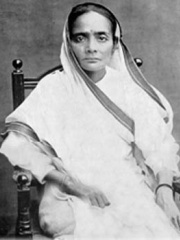
5. Kasturba Gandhi (1869 - 1944)
With an HPI of 68.00, Kasturba Gandhi is the 5th most famous Indian Social Activist. Her biography has been translated into 40 different languages.
Kasturba Mohandas Gandhi (, born Kasturba Gokuldas Kapadia; 11 April 1869 – 22 February 1944) was an Indian political activist who was involved in the Indian independence movement during British India. She was married to Mohandas Karamchand Gandhi, commonly known as Mahatma Gandhi. National Safe Motherhood Day is observed in India annually on 11 April, coinciding with Kasturba's birthday.

6. Lal Bahadur Shastri (1904 - 1966)
With an HPI of 66.58, Lal Bahadur Shastri is the 6th most famous Indian Social Activist. His biography has been translated into 67 different languages.
Lal Bahadur Shastri (2 October 1904 – 11 January 1966) was an Indian politician and statesman who served as the prime minister of India from 1964 to 1966. He previously served as home minister from 1961 to 1963. Shastri was born to Sharad Prasad Srivastava and Ramdulari Devi in Mughalsarai on 2 October 1904. He studied in East Central Railway Inter college and the Harish Chandra High School, which he left to join the non-cooperation movement. He worked for the betterment of the Harijans at Muzaffarpur and dropped his caste-derived surname of "Srivastava". Influenced by Mahatma Gandhi, he joined the Indian Independence movement in the 1920s. He served as the president of Servants of the People Society, founded by Lala Lajpat Rai and held prominent positions in the Indian National Congress (INC). Following Indian independence in 1947, Shastri led several union ministries under prime minister Jawaharlal Nehru. As prime minister, Shastri promoted the White revolution (India), a national campaign to increase the production and supply of milk, by supporting the Amul milk co-operative and creating the National Dairy Development Board. Underlining the need to boost India's food production, Shastri also promoted the Green Revolution in India in 1965. This led to an increase in food grain production, especially in the states of Punjab, Haryana and Uttar Pradesh. He led the country during the Indo-Pakistani war of 1965. His slogan "Jai Jawan, Jai Kisan" ("Hail to the soldier; Hail to the farmer") became very popular during the war. The war formally ended with the Tashkent Declaration on 10 January 1966; Shastri died the next day.

7. Gangubai Kothewali (1939 - 1977)
With an HPI of 66.57, Gangubai Kothewali is the 7th most famous Indian Social Activist. Her biography has been translated into 19 different languages.
Gangubai Harjeevandas (1907 – 8 September 1977), better known as Gangubai Kothewali or Gangubai Kathiawadi, was an Indian social activist, sex worker and madam of a brothel in the Kamathipura area of Mumbai during the 1960s. Gangubai worked for the rights of sex workers and for the well-being of orphans. She gradually ended up operating her own brothel and is known to also have lobbied for the rights of commercial sex workers.

8. Vinoba Bhave (1895 - 1982)
With an HPI of 65.67, Vinoba Bhave is the 8th most famous Indian Social Activist. His biography has been translated into 40 different languages.
Vinayak Narahar Bhave, also known as Vinoba Bhave (; 11 September 1895 – 15 November 1982), was an Indian advocate of nonviolence and human rights. Often called Acharya (Teacher in Sanskrit), he is best known for the Bhoodan Movement. He is considered as National Teacher of India and the spiritual successor of Mahatma Gandhi. He was an eminent philosopher. He translated the Bhagavad Gita into the Marathi language with the title Geetai (meaning 'Mother Gīta' in Marathi).

9. Kailash Satyarthi (b. 1954)
With an HPI of 65.39, Kailash Satyarthi is the 9th most famous Indian Social Activist. His biography has been translated into 72 different languages.
Kailash Satyarthi (born 11 January 1954) is an Indian social reformer who campaigned against child labor in India and advocated for the universal right to education and right to life for children. In 2014, he was the co-recipient of the Nobel Peace Prize, along with Malala Yousafzai, "for their struggle against the suppression of children and young people and for the right of all children to education." He is the founder of multiple social activist organizations, including Bachpan Bachao Andolan, Global March Against Child Labour, Global Campaign for Education, Kailash Satyarthi Children's Foundation, and Bal Ashram Trust. Kailash Satyarthi and his team at Bachpan Bachao Andolan have liberated more than 1,30,000 children in India from child labour, slavery and trafficking. In 1998, Satyarthi conceived and led the Global March against Child Labour, an 80,000 km (ca. 49,710 mi)-long march across 103 countries to put forth a global demand against worst forms of child labour. This became one of the largest social movements ever on behalf of exploited children. The demands of the marchers, which included children and youth (particularly the survivors of trafficking for forced labor, exploitation, sexual abuse, illegal organ transplants, armed conflict, etc.) were reflected in the draft of the ILO Convention 182 on the Worst Forms of Child Labour. The following year, the Convention was unanimously adopted at the ILO Conference in Geneva. He has served on the board and committee of several international organizations including the Center for Victims of Torture (USA), the International Labour Rights Fund (USA), and the Cocoa Initiative. Satyarthi was among Fortune magazine's "World's Greatest Leaders" in 2015 and featured in LinkedIn's Power Profiles List in 2017 and 2018. Satyarthi led a nationwide march, Bharat Yatra, in India covering 19,000 km (12,000 mi) in 35 days, to demand for legislation against child rape and child prostitution.
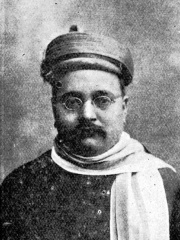
10. Gopal Krishna Gokhale (1866 - 1915)
With an HPI of 64.85, Gopal Krishna Gokhale is the 10th most famous Indian Social Activist. His biography has been translated into 37 different languages.
Gopal Krishna Gokhale ( [ˈɡoːpaːl ˈkrɪʂɳə ˈɡoːkʰleː] 9 May 1866 – 19 February 1915) was an Indian political leader and a social reformer during the Indian independence movement, and political mentor of Indian freedom fighter Mahatma Gandhi. Gokhale was a senior leader of the Indian National Congress and the founder of the Servants of India Society. Through the Society as well as the Congress and other legislative bodies he served in, Gokhale campaigned for Indian self-rule and social reforms. He was the leader of the moderate faction of the Congress that advocated reforms by working with existing government institutions, and a major member of the Poona Association or the Poona Sarvajanik Sabha.
People
Pantheon has 68 people classified as Indian social activists born between 1778 and 2011. Of these 68, 20 (29.41%) of them are still alive today. The most famous living Indian social activists include Kailash Satyarthi, Vandana Shiva, and Anna Hazare. The most famous deceased Indian social activists include Mahatma Gandhi, Syed Ahmad Khan, and Gerald Durrell. As of April 2024, 6 new Indian social activists have been added to Pantheon including Rahibai Soma Popere, Salil Shetty, and Sampat Pal Devi.
Living Indian Social Activists
Go to all RankingsKailash Satyarthi
1954 - Present
HPI: 65.39
Vandana Shiva
1952 - Present
HPI: 63.47
Anna Hazare
1937 - Present
HPI: 61.09
Satish Kumar
1936 - Present
HPI: 59.57
Irom Chanu Sharmila
1972 - Present
HPI: 56.98
Sumaira Abdulali
1961 - Present
HPI: 51.43
Jadav Payeng
1963 - Present
HPI: 50.30
Medha Patkar
1954 - Present
HPI: 50.28
Rajmohan Gandhi
1935 - Present
HPI: 48.65
Manasi Pradhan
1962 - Present
HPI: 47.60
Laxmi Agarwal
1990 - Present
HPI: 47.24
Rahibai Soma Popere
1964 - Present
HPI: 42.84
Deceased Indian Social Activists
Go to all RankingsMahatma Gandhi
1869 - 1948
HPI: 97.71
Syed Ahmad Khan
1817 - 1898
HPI: 73.23
Gerald Durrell
1925 - 1995
HPI: 73.19
Bal Gangadhar Tilak
1856 - 1920
HPI: 70.04
Kasturba Gandhi
1869 - 1944
HPI: 68.00
Lal Bahadur Shastri
1904 - 1966
HPI: 66.58
Gangubai Kothewali
1939 - 1977
HPI: 66.57
Vinoba Bhave
1895 - 1982
HPI: 65.67
Gopal Krishna Gokhale
1866 - 1915
HPI: 64.85
Mangal Pandey
1827 - 1857
HPI: 64.55
Kittur Chennamma
1778 - 1829
HPI: 64.13
Mohammad Ali Jauhar
1878 - 1931
HPI: 63.49
Newly Added Indian Social Activists (2025)
Go to all RankingsRahibai Soma Popere
1964 - Present
HPI: 42.84
Salil Shetty
1961 - Present
HPI: 41.82
Sampat Pal Devi
1961 - Present
HPI: 41.74
Teesta Setalvad
1962 - Present
HPI: 37.70
Bhakti Sharma
1989 - Present
HPI: 30.12
Kirthi Jayakumar
1987 - Present
HPI: 26.09
Overlapping Lives
Which Social Activists were alive at the same time? This visualization shows the lifespans of the 25 most globally memorable Social Activists since 1700.

